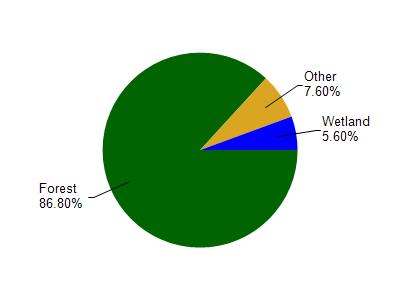Bayfield
Yes
No
No
Fish and Aquatic Life
Overview
This river drains mostly sandy, red clay soils that are subject to severe erosion during periods of high runoff. This results in much of the upper stream channel filling in and becoming cluttered with debris. Much of the watershed is forested, with some agricultural lands. The lower reaches of the river pass through the Red Cliff Indian Reservation, with other portions of the watershed in county forest or private ownership. Areas of the watershed are subject to clearcutting and logging traffic.
The river drains into Raspberry Bay on Lake Superior, which has a sand, gravel and rock shoreline. Wetlands line the last mile of the Raspberry River. This last mile is considered Class II trout waters and contains important fish habitat, especially for brown trout, and is used by spawning rainbow trout. The Lake Superior Binational Program has identified this area as important to the integrity of the Lake Superior ecosystem for coastal wetlands and fish and wildlife spawning and nursery grounds. The shoreline area is part of the Apostle Islands National Lakeshore.
During survey work conducted as part of the coastal wetlands evaluation, no rare species of macroinvertebrates were found and overall taxa richness was low (0-4 species) (Epstein 1997). Streambank erosion and low flows were significant contributors to impaired habitat quality and turbidity is present.
Date 1999
Author Aquatic Biologist
Condition
Wisconsin has over 84,000 miles of streams, 15,000 lakes and milllions of acres of wetlands. Assessing the condition of this vast amount of water is challenging. The state's water monitoring program uses a media-based, cross-program approach to analyze water condition. An updated monitoring strategy (2015-2020) is now available. Compliance with Clean Water Act fishable, swimmable standards are located in the Executive Summary of Water Condition in 2018. See also the 'monitoring and projects' tab.
Reports
Management Goals
Wisconsin's Water Quality Standards provide qualitative and quantitative goals for waters that are protective of Fishable, Swimmable conditions [Learn more]. Waters that do not meet water quality standards are considered impaired and restoration actions are planned and carried out until the water is once again fishable and swimmable
Management goals can include creation or implementation of a Total Maximum Daily Load analysis, a Nine Key Element Plan, or other restoration work, education and outreach and more. If specific recommendations exist for this water, they will be displayed below online.
Monitoring
Monitoring the condition of a river, stream, or lake includes gathering physical, chemical, biological, and habitat data. Comprehensive studies often gather all these parameters in great detail, while lighter assessment events will involve sampling physical, chemical and biological data such as macroinvertebrates. Aquatic macroinvertebrates and fish communities integrate watershed or catchment condition, providing great insight into overall ecosystem health. Chemical and habitat parameters tell researchers more about human induced problems including contaminated runoff, point source dischargers, or habitat issues that foster or limit the potential of aquatic communities to thrive in a given area. Wisconsin's Water Monitoring Strategy was recenty updated.
Grants and Management Projects
| Project Name (Click for Details) | Year Started |
|---|
|
|
Monitoring Projects
| WBIC | Official Waterbody Name | Station ID | Station Name | Earliest Fieldwork Date | Latest Fieldwork Date | View Station | View Data |
|---|
| 2883800 | Raspberry River | 10051022 | Raspberry River - at mouth RRM01 | 8/23/2018 | 7/12/2022 | Map | Data |
| 2883800 | Raspberry River | 10051024 | Raspberry River - at Rowley Road RR03 | | | Map | Data |
| 2883800 | Raspberry River | 10051025 | Rasberry River - RR01 | | | Map | Data |
| 2883800 | Raspberry River | 10038139 | Raspberry River .35 miles DS of park canoe launch | 9/19/2012 | 9/19/2012 | Map | Data |
| 2883800 | Raspberry River | 10037205 | Raspberry River at Blueberry Rd | 6/5/2012 | 1/1/2015 | Map | Data |
| 2883800 | Raspberry River | 10047360 | Raspberry River - Rowley Rd | 1/1/2015 | 1/1/2015 | Map | Data |
|

Watershed Characteristics
Raspberry River is located in the Bayfield Peninsula Southeast watershed which is 301.48 mi². Land use in the watershed is primarily forest (86.80%), wetland (5.60%) and a mix of grassland (4.10%) and other uses (3.50%). This watershed has 453.79 stream miles, 291,749.17 lake acres and 6,560.31 wetland acres.
Nonpoint Source Characteristics
This watershed is ranked Not Ranked for runoff impacts on streams, Not Available for runoff impacts on lakes and Low for runoff impacts on groundwater and therefore has an overall rank of Low. This value can be used in ranking the watershed or individual waterbodies for grant funding under state and county programs.However, all waters are affected by diffuse pollutant sources regardless of initial water quality. Applications for specific runoff projects under state or county grant programs may be pursued. For more information, go to surface water program grants.